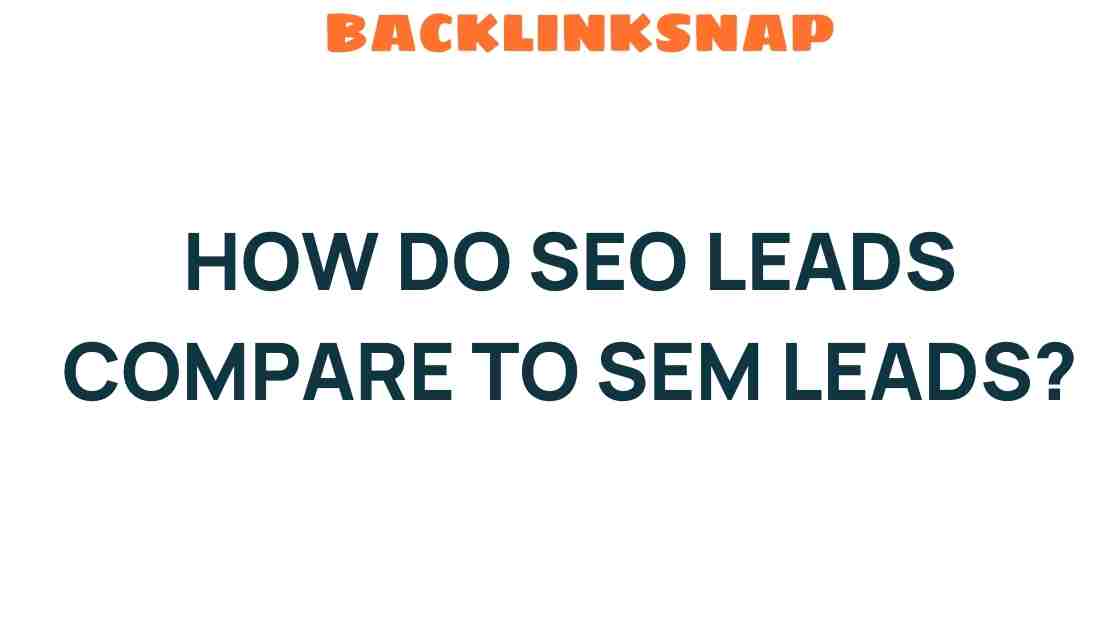SEO Leads vs. SEM Leads: Unveiling the Key Differences
In the ever-evolving landscape of digital marketing, understanding the nuances between SEO leads and SEM leads is crucial for businesses aiming to maximize their lead generation efforts. While both strategies focus on attracting potential customers through search engines, they utilize distinctly different methodologies, and their effectiveness can vary greatly depending on the specific goals of a campaign. This article unpacks these differences, providing insights into how businesses can leverage both strategies to enhance their marketing initiatives.
Understanding SEO Leads
Search Engine Optimization (SEO) is a digital marketing strategy that focuses on improving a website’s visibility in organic search results. When we talk about SEO leads, we’re referring to the potential customers who land on your site through unpaid search results. This process is often organic and relies heavily on the quality of the content, keywords, and overall site structure.
SEO leads are typically characterized by:
- Cost-Effectiveness: Since SEO targets organic traffic, it can be less expensive over time compared to paid advertising. However, it requires an initial investment in content creation and optimization.
- Long-Term Value: Once your website ranks well for specific keywords, it can continue to attract leads without ongoing costs, making it a sustainable strategy.
- Higher Trust Levels: Users often perceive organic results as more trustworthy than paid ads. This trust can lead to higher conversion rates.
The Role of SEM Leads
Search Engine Marketing (SEM), on the other hand, involves paid advertising strategies, such as pay-per-click (PPC) campaigns. When we refer to SEM leads, we’re talking about potential customers who find your business through these paid advertisements. SEM is about quickly gaining visibility on search engines, enabling businesses to reach a broader audience almost immediately.
Key characteristics of SEM leads include:
- Immediate Results: Unlike SEO, which can take time to yield results, SEM can drive traffic to your website as soon as a campaign is launched.
- Targeted Advertising: SEM allows for precise targeting, enabling businesses to reach specific demographics, geographic areas, and even user behaviors.
- Measurable Results: With SEM, it’s easy to track the performance of your ads, making it simpler to adjust campaigns based on real-time data.
Comparing SEO Leads and SEM Leads
While both SEO leads and SEM leads serve a common purpose—generating leads—they differ in several key areas:
1. Cost Structure
SEO is often seen as a long-term investment. Although it requires upfront costs for content creation and optimization, it generally becomes cheaper over time once the site gains traction. In contrast, SEM can be costly, especially in competitive industries where bids for keywords can skyrocket. Businesses must carefully manage their budgets to avoid overspending.
2. Time to Results
As mentioned, SEO takes time to build authority and visibility, which means businesses may not see immediate leads. SEM, however, can produce leads almost instantaneously. For companies looking to generate quick leads, SEM is often the preferred choice.
3. Targeting and Reach
SEO relies on optimizing content for search engines based on keywords that users are searching for. This means that while SEO can attract a broad audience, it may not always be precisely targeted. SEM, on the other hand, allows for specific targeting, making it possible to reach users who are actively searching for your products or services.
4. Conversion Rates
Conversion rates can vary significantly between the two methods. Generally, SEO leads tend to convert better because they come from users who trust organic search results and are often further along in the buying process. SEM leads, while targeted, might include users who are just browsing or comparing options, which can lead to lower conversion rates.
Complementary Strategies: Combining SEO and SEM
Rather than viewing SEO leads and SEM leads as mutually exclusive, businesses should consider integrating both strategies into their marketing plans. Here’s how:
- Utilize SEO for Long-Term Growth: Invest in quality content and optimization to build a solid organic presence that can drive ongoing traffic.
- Use SEM for Immediate Needs: Run targeted SEM campaigns for specific promotions, product launches, or events to generate immediate leads.
- Data-Driven Insights: Leverage the data from SEM campaigns to inform your SEO strategy. Understanding which keywords convert well in paid ads can guide your organic content efforts.
Conclusion
In the realm of digital marketing, understanding the differences between SEO leads and SEM leads is essential for crafting effective marketing strategies. While SEO provides a cost-effective, long-term approach to lead generation, SEM offers the immediate visibility that many businesses need. By recognizing the strengths of each method and integrating them into a cohesive strategy, companies can enhance their lead generation efforts and ultimately improve their conversion rates.
FAQs
- What are SEO leads? SEO leads are potential customers who find your website through organic search results, typically generated through search engine optimization strategies.
- What are SEM leads? SEM leads are potential customers who arrive at your site through paid advertising efforts on search engines.
- Which is better for lead generation, SEO or SEM? It depends on your goals; SEO is better for long-term growth while SEM is ideal for immediate results.
- Can I use both SEO and SEM together? Absolutely! Combining both strategies can maximize your reach and effectiveness in lead generation.
- How do conversion rates differ between SEO and SEM? Typically, SEO leads convert at higher rates due to increased trust in organic results compared to paid ads.
- What should I focus on first, SEO or SEM? It often depends on your current needs; if you need quick results, start with SEM, but don’t neglect building your SEO strategy for the long haul.
For further reading on optimizing your digital marketing strategies, visit Moz’s Beginner’s Guide to SEO or check out WordStream’s insights on SEM.
This article is in the category Digital Marketing and created by BacklinkSnap Team




